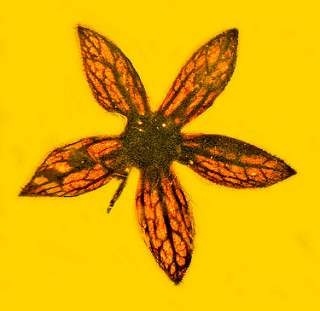
Seven complete specimens of 100-million-year-old flowers have been discovered in Myanmar. The flowers are only 3.4-5.0 mm small and were likely dislodged from a tree by a Triceratops or Tyrannosaurus rex passing through the jungle. The flowers fell into resin deposits on the bark of an araucaria tree; the resin then fossilized into amber. Named Tropidogyne pentaptera for the Greek words for five (penta) and wing (pteron), the flowers are part of the Cunoniaceae family found in Australia and Papua New Guinea. Researchers believe that the flowers were likely encased in amber some time before the supercontinent of Gondwanaland broke up, which would explain how a species found in Myanmar could be related to modern-day flowers in Australia.
This study builds on earlier research also involving Burmese amber in which Poinar and Chambers described another species in the same angiosperm genus, Tropidogyne pikei; that species was named for its flower’s discoverer, Ted Pike. Findings were recently published in Paleodiversity.
“The new species has spreading, veiny sepals, a nectar disc, and a ribbed inferior ovary like T. pikei,” Poinar said. “But it’s different in that it’s bicarpellate, with two elongated and slender styles, and the ribs of its inferior ovary don’t have darkly pigmented terminal glands like T. pikei.”
Both species have been placed in the extant family Cunoniaceae, a widespread Southern Hemisphere family of 27 genera.
Poinar said T. pentaptera was probably a rainforest tree.
“In their general shape and venation pattern, the fossil flowers closely resemble those of the genus Ceratopetalum that occur in Australia and Papua-New Guinea,” he said. “One extant species is C. gummiferum, which is known as the New South Wales Christmas bush because its five sepals turn bright reddish pink close to Christmas.”
Another extant species in Australia is the coach wood tree, C. apetalum, which like the new species has no petals, only sepals. The towering coach wood tree grows to heights of greater than 120 feet, can live for centuries and produces lumber for flooring, furniture and cabinetwork.
So what explains the relationship between a mid-Cretaceous Tropidogyne from Myanmar, formerly known as Burma, and an extant Ceratopetalum from Australia, more than 4,000 miles and an ocean away to the southeast?
That’s easy, Poinar said, if you consider the geological history of the regions.
“Probably the amber site in Myanmar was part of Greater India that separated from the southern hemisphere, the supercontinent Gondwanaland, and drifted to southern Asia,” he said. “Malaysia, including Burma, was formed during the Paleozoic and Mesozoic eras by subduction of terranes that successfully separated and then moved northward by continental drift.”
Credit : Science Daily
Picture Credit : Google




